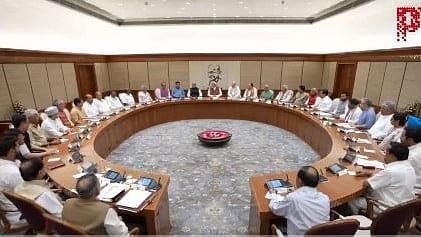
Modi 3.0 first cabinet meeting
Credit: PTI Photo
India Inc has assigned a value of $400 billion to the one-man, one-party rule of the Modi government on its third term. That is the total stock market value lost by BSE-listed stocks on the counting day of June 4, when the BJP, rather than securing a big majority, as projected by the exit polls, was found to just be able to form a coalition government.
Once it was perceived that the Modi 3.0 coalition government could be as decisive as the earlier two versions, stock markets recovered their losses and even touched new highs within a span of eight trading days. On June 14, the Nifty 50 touched a new high of 23,490. So was the case with midcap and small cap indices. The Nifty Midcap 100 Index recovered from an intra-day low of 47,246 recorded on June 4 to close at a record high of 55,226 on June 14.
The BJP’s two main coalition partners, the TDP and JD (U), are seen as being amenable to Modi’s vision for the Indian economy. The key ministries of finance, defence, commerce, home, and external affairs remain with the BJP, and the same ministers of the Modi 2.0 government will handle these ministries in 3.0 as well, bringing an element of stability and continuity to the policy framework. For now, it would be “business as usual,” said Bhaskar Chakravorti, dean of global business at the Fletcher School at Tufts University.
It is clear that India Inc and stock market investors perceive the Modi 3.0 government as being pro-business, in spite of coalition constraints, if any. It was the Modi 2.0 government that drastically reduced the corporate tax rate from 30 per cent to 22 per cent in 2019–20. The Modi 2.0 government had also announced a lower rate of 15 per cent for newly incorporated domestic companies. It had also announced an outlay of Rs 1.97 lakh crore for the Production-Linked Incentive (PLI) schemes across 14 key sectors to create national manufacturing champions. Modi’s vision for India rests on the growth of a few giant companies, at the cost of the labour-intensive SME sector.
“It would appear [Modi] has decided to back certain horses; these are the Hyundais, these are the Samsungs of India,” economist Swaminathan Aiyar was quoted by Financial Times in a recent article referring to the chaebol conglomerates that dominate South Korea’s economy. “He thinks these guys can do it.”
The Modi government’s large spending on public infrastructure also augurs well for the corporate sector for better logistics and improved industrial demand, while the private sector sweats the existing capital with hardly any fresh investments in green field projects.
While addressing a webinar hosted by DIPAM in 2021, Prime Minister Narendra Modi said the government has decided to monetize 100 PSUs valued at Rs 2.5 lakh crore. The government has “no business” to be in business, as the Prime Minister famously said. Private sector giants have an unsatiable hunger to grab valuable public assets in key sectors. Adani Group’s market cap has skyrocketed from $8.42 billion in 2014 to $43.99 billion as of June 2024, mainly powered by inorganic growth, the takeover of public assets, and entry into the government’s preferred sectors such as green energy, power, and ports.
The Opposition’s criticism is that the tax burden has shifted from corporates to people, and the Modi government curtails public subsidies to finance the largesse given to the corporate sector. There has been no substantial reduction in personal income tax rates under the Modi regime.
GST rates, which indirectly tax even the poorest of the poor, are high for many items. The Modi government has raised excise duties on petrol, diesel, and cooking gas. More money in the hands of the common man would have spurred consumption and stimulated private capital investment, which accounts for about 25 per cent of GDP.
The economic policy of giving concessions to the corporate sector and squeezing the common people, the economic policy of nurturing large corporates and national champions at the cost of the SME sector, and the economic policy of growth without employment generation may be shortsighted. But these policies definitely boost corporate profits and stock prices in the short term.
(The writer is a retired corporate professional)